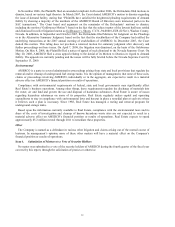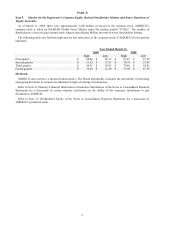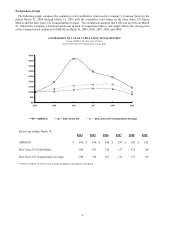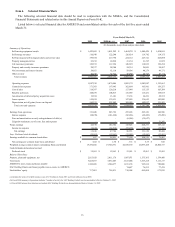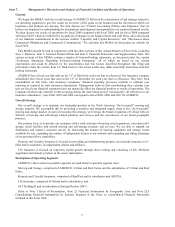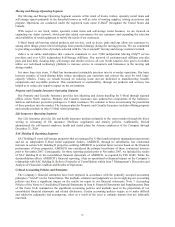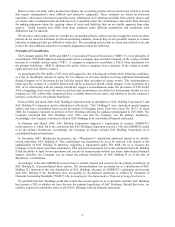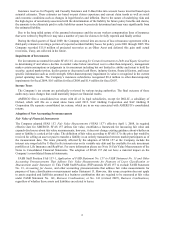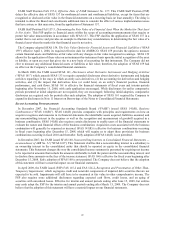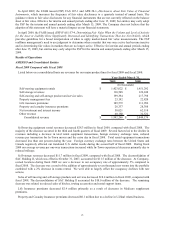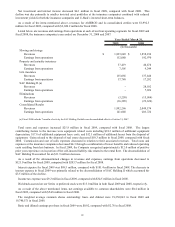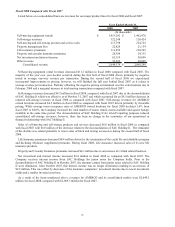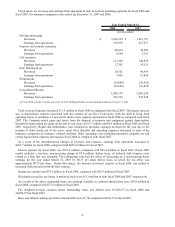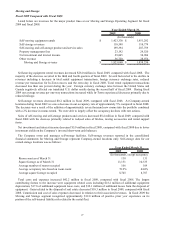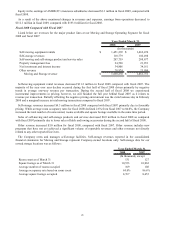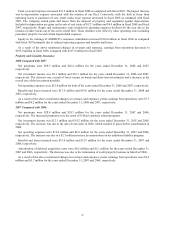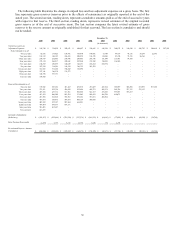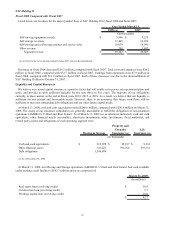U-Haul 2009 Annual Report Download - page 26
Download and view the complete annual report
Please find page 26 of the 2009 U-Haul annual report below. You can navigate through the pages in the report by either clicking on the pages listed below, or by using the keyword search tool below to find specific information within the annual report. 22
FASB Staff Position FAS 157-2, Effective Date of FASB Statement No. 157. This FASB Staff Position (FSP)
delays the effective date of SFAS 157 for nonfinancial assets and nonfinancial liabilities, except for items that are
recognized or disclosed at fair value in the financial statements on a recurring basis (at least annually). The delay is
intended to allow the Board and constituents additional time to consider the effect of various implementation issues
that have arisen, or that may arise, from the application of Statement 157.
FASB Staff Position FAS 157-3, Determining the Fair Value of a Financial Asset When the Market for That Asset
Is Not Active. This FSP applies to financial assets within the scope of accounting pronouncements that require or
permit fair value measurements in accordance with SFAS 157. This FSP clarifies the application of SFAS 157 in a
market that is not active and provides an example to illustrate key considerations in determining the fair value of a
financial asset when the market for that financial asset is not active.
The Company adopted SFAS 159, The Fair Value Option for Financial Assets and Financial Liabilities (“SFAS
159”) effective April 1, 2008, its required effective date for AMERCO. SFAS 159 provides the option to measure
certain financial assets and liabilities at fair value with any changes in fair value recognized in earnings. SFAS 159
allows for the application of these rules on an instrument-by-instrument basis upon the initial recognition of the asset
or liability, or upon an event that gives rise to a new basis of accounting for that instrument. The Company did not
elect to measure any additional financial assets or liabilities at fair value; therefore, the adoption of SFAS 159 had
no effect on the Company’s consolidated financial statements.
In March 2008, the FASB issued SFAS 161, Disclosures about Derivative Instruments and Hedging Activities
(“SFAS 161”) which amends SFAS 133 to require expanded disclosures about derivative instruments and hedging
activities regarding (1) the ways in which an entity uses derivatives, (2) the accounting for derivatives and hedging
activities, and (3) the impact that derivatives have (or could have) on an entity's financial position, financial
performance, and cash flows. SFAS 161 is effective for financial statements of fiscal years and interim periods
beginning after November 15, 2008, with early application encouraged. While disclosures for earlier comparative
periods presented at initial adoption are not required, they are encouraged; following initial adoption, comparative
disclosures are required only for periods after such adoption. The adoption of SFAS 161 required the Company to
expand its disclosures in Note 11 Interest on Borrowings of the Notes to Consolidated Financial Statements.
Recent Accounting Pronouncements
In December 2007, the Financial Accounting Standards Board (“FASB”) issued SFAS 141(R), Business
Combinations (“SFAS 141(R)”). SFAS 141(R) provides companies with principles and requirements on how an
acquirer recognizes and measures in its financial statements the identifiable assets acquired, liabilities assumed, and
any noncontrolling interest in the acquiree as well as the recognition and measurement of goodwill acquired in a
business combination. SFAS 141(R) also requires certain disclosures to enable users of the financial statements to
evaluate the nature and financial effects of the business combination. Acquisition costs associated with the business
combination will generally be expensed as incurred. SFAS 141(R) is effective for business combinations occurring
in fiscal years beginning after December 15, 2008, which will require us to adopt these provisions for business
combinations occurring in fiscal 2010 and thereafter. Early adoption of SFAS 141(R) is not permitted.
In December 2007, the FASB issued SFAS 160, Noncontrolling Interests in Consolidated Financial Statements —
an amendment of ARB No. 51 (“SFAS 160”). This Statement clarifies that a noncontrolling interest in a subsidiary is
an ownership interest in the consolidated entity that should be reported as equity in the consolidated financial
statements. This Statement changes the way the consolidated income statement is presented by requiring net income
to be reported at amounts that include the amounts attributable to both the parent and the noncontrolling interest and
to disclose those amounts on the face of the income statement. SFAS 160 is effective for fiscal years beginning after
December 15, 2008. Early adoption of SFAS 160 is not permitted. The Company does not believe that the adoption
of this statement will have a material impact on our financial statements.
In April 2009, the FASB issued (FSP) FAS 115-2 and FAS 124-2, Recognition and Presentation of Other-Than-
Temporary Impairments, which segregates credit and noncredit components of impaired debt securities that are not
expected to be sold. Impairments will still have to be measured at fair value in other comprehensive income. The
FSP also requires some additional disclosures regarding expected cash flows, credit losses, and an aging of
securities with unrealized losses. Effective for interim and annual periods ending after June 15, 2009, but entities
may early adopt the FSP for the interim and annual periods ending after March 15, 2009. The Company does not
believe that the adoption of this statement will have a material impact on our financial statements.


